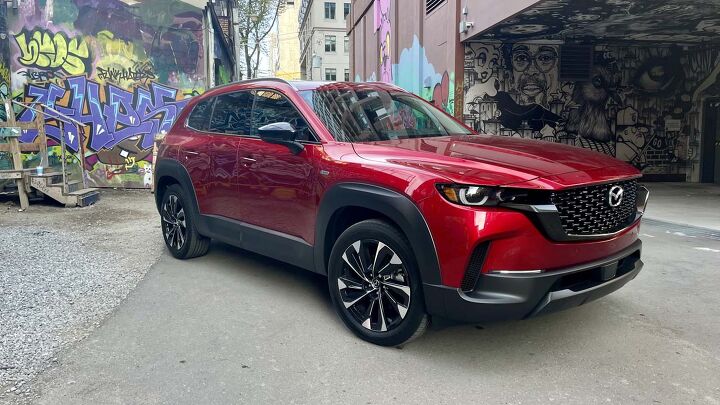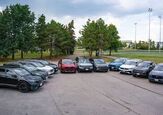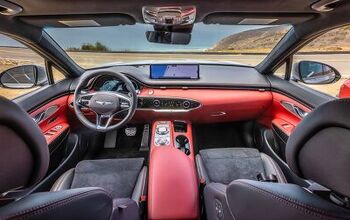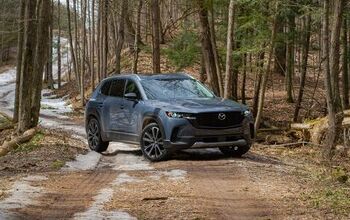First Drive Review: 2025 Mazda CX-50 Hybrid

One of the main benefits of automotive partnerships is the sharing of technology, which can help get new products to market faster.
Back in 2017, Toyota and Mazda signed a capital alliance agreement enabling the two companies to own small stakes of equal value in each other. As a result, Toyota now owns five percent of Mazda, and Mazda owns 0.25 percent of Toyota. Equal value shares enable both companies to remain independent.
The rationale for the deal is collaboration on projects, including electrified vehicles and a jointly run U.S. assembly plant. Seven years later, that plant, located in Huntsville, Alabama, builds the Toyota Corolla Cross, Corolla Cross Hybrid, and the Mazda CX-50 for North America, and the latter is now available as a hybrid.
And, as you may have guessed, the CX-50 Hybrid has a Toyota Hybrid System powertrain. The aim is to deliver a handsome, well-equipped, versatile SUV with fuel savings as an attractive sweetener. As we discovered, the package has a lot going for it.
Quick Take
The 2025 Mazda CX-50 Hybrid offers the same handsome, sporty looks, and rugged off-road capability as its gas-powered sibling, but with much improved fuel economy thanks to the presence of the Toyota Hybrid System. Fuel efficiency is about 40 percent better than a comparable CX-50 gas model yet delivers many of the same benefits such as standard all-wheel drive, a well-stocked interior, and a smooth ride, along with decent performance.
First Drive Review 2025 Mazda CX-50 Hybrid: All The Details
What’s New For 2025
Technically, it’s all new given the 2025 Mazda CX-50 is a new model, but because it shares a lot in common with its gas-powered sibling, I’ll focus on what separates the two, namely hybridization. The big news here is that the CX-50 Hybrid uses the Toyota Hybrid System powertrain, which is comprised of a 2.5-liter naturally aspirated four-cylinder engine, 1.59 kWh nickel-metal hydride battery, three electric motors (two front, one rear), a CVT, and standard electric all-wheel drive.
Exterior Style
I’ll be brief here as the CX-50 Hybrid doesn’t differ markedly from its gas sibling, but Mazda has made some minor styling changes to separate the two. The main exterior changes for the Hybrid include a redesigned lower front bumper, restyled body cladding, and unique 17-inch and 19-inch wheel designs. It’s also 1.4 inches (35 mm) taller than the gas model.
Generally, the CX-50 Hybrid retains the rugged, sporty styling of its gas-powered sibling, with styling cues that include standard LED headlights and taillights, roof rails, and dual exhaust finishers.
Powertrain and Fuel Economy
The CX-50 Hybrid is powered by the Toyota Hybrid System which features a 2.5-liter naturally aspirated four-cylinder engine, 1.59 kWh nickel-metal hydride battery, three electric motors (two front, one rear), electronic CVT, and standard electric all-wheel drive. Total system output is rated at 219 horsepower and 163 lb-ft. of torque, which runs on regular 87-octane gas.
Despite its relatively big horsepower rating, the CX-50 Hybrid isn’t built for performance. With the drive mode selector toggled to power, normal and trail are also available, acceleration feels zippier, but the car isn’t fast. It’s certainly quick enough for the sort of mixed urban and suburban driving I performed during the press preview, but the drive isn’t very engaging. The CVT doesn’t help in this regard, as there’s no meaningful way to use higher revs to propel the car forward in a dynamic way. It just pushes the car along without much enthusiasm. This is mostly fine because hybrid tech is there for fuel saving and this powertrain does a fine job of that.
Fuel economy for the CX-50 Hybrid is rated at an estimated 38 mpg combined, which is about 40 percent better than the CX-50 2.5 S gas model. Mazda estimates the Hybrid will save about $575 USD in fuel costs per year compared to the 2.5 S. For comparison, the 2.5 S uses Mazda’s Skyactiv 2.5-liter four-cylinder engine which produces 187 horsepower and 185 lb-ft. of torque and is paired with a six-speed automatic transmission and standard AWD.
In Canada, the CX-50 Hybrid is rated at 6.2 L/100 km combined, which is about 40 percent more efficient than the base CX-50 GS-L, which features the same Skyactiv 2.5-liter engine as the 2.5 S.
Ride Quality and Comfort
My big takeaway regarding ride quality for the CX-50 Hybrid is that it isn’t as harsh and jittery as the gas models I’ve driven. Despite having the same MacPherson strut/torsion beam set-up, the suspension on the Premium Plus Hybrid I drove (GT in Canada) just didn’t feel as busy as the gas CX-50. I think the smaller wheels (19-inch versus 20), and thicker sidewall tires (45 versus 55) contributed greatly to that impression. The Hybrid’s non-turbo, more thrifty than sporty aesthetic also helped drive that perception.
The bottom line, the CX-50 Hybrid is a smooth rider. It absorbed all but the worst potholes and cracked pavement well, and delivered a whisper-quiet ride, except under hard acceleration. Even then, its hybrid powertrain wasn’t harsh or noisy.
On the inside, the CX-50 Hybrid is just as welcoming and up-market as its gas cousins. The Premium Plus grade comes fully loaded, including leather seating, heated and ventilated front seats, heated rear seats, a panoramic roof, Bose 12-speaker premium audio, color head-up display, and more.
Interior Style and Quality
Mazda has a well-earned reputation for finely crafted and premium-edged interiors, and the CX-50 Hybrid is no exception.
Soft touch surfaces abound and are wrapped in a contemporary design that emphasizes simplicity and ease of use. There are relatively few buttons and knobs, but they operate with smooth and straightforward precision. The general impression I’m left with is the cabin feels artful. The two-tone black and terracotta (brown) color scheme, smooth clicking black buttons, satin chrome detailing, and plush leather seats exudes a premium feel, even though Mazda isn’t a premium brand.
Of note, leatherette is standard on the base Preferred in the U.S., (GS-L in Canada), but leather seating is standard on the two upper grades, with red unique to CX-50 Hybrid. In Canada, red is available on the mid-level Hybrid Kuro, terracotta can be had on the Hybrid GT, and black is available for both.
As for space, the Hybrid has the same interior capacities as the gas models, with a maximum cargo volume of 56.3 cubic feet (1,594 liters) with the second-row seatbacks folded down. Maximum towing is rated at 1,500 pounds (680 kg).
Tech and Safety
The CX-50 Hybrid comes with a healthy tech offering on all grades, with standard equipment that includes a 10.25-inch multimedia display, seven-inch LCD instrument cluster screen, wireless Apple CarPlay and wireless Android Auto, Alexa built-in, and wireless phone charger. An 8-speaker audio system is also standard, but a premium 12-speaker Bose stereo is bundled with the Premium grade in the U.S., and the GT in Canada. Four USB-C ports are also standard, with two up front and two in the rear.
As for safety, Mazda is loading the CX-50 Hybrid with a broad suite of standard features including blind spot monitoring, smart brake support with head-on collision mitigation, emergency lane keeping with road keep assist, lane-keep assist, rear cross-traffic alert, and a lot more.
Value Dollars and Sense
The 2025 Mazda CX-50 Hybrid comes in three trims in both the U.S. and Canada. In the U.S., there’s Preferred, Premium, and Premium Plus. The Preferred starts at $35,390, with the Premium checking in at $38,820, while the Premium Plus has a list price of $41,470. All figures include destination.
In Canada, the CX-50 Hybrid GS-L starts at $45,095, with the Hybrid Kuro beginning at $46,945, and the Hybrid GT checking in at $50,445. As with U.S. pricing, all figures include destination.
Looking at the equipment list, it’s impressive to see how much comes standard. One needn’t go up the grade walk to get items like heated front seats, a wireless phone charger, or advanced safety features. Even a power liftgate is standard. Premium and Premium Plus grades offer things like leather seating, a fancier audio system, bigger alloy wheels, and panoramic moonroof, but the list of extras is relatively short.
Final Thoughts: 2025 Mazda CX-50 Hybrid First Drive Review
Mazda sells plug-in hybrids for its bigger CX-70 and CX-90 SUVs, but the CX-50 is the only gas hybrid in its lineup. Given how big the compact SUV segment is, Mazda has chosen the ideal entry point with the CX-50. Mazda aims to deliver about 100,000 CX-50s in the U.S. in 2025, and about 40 percent are expected to be hybrids. With hybrid sales expected to grow industry-wide, the CX-50 Hybrid’s arrival feels well-timed.
With its impressive fuel efficiency, smooth ride, upmarket interior, and strong content offer, the CX-50 Hybrid should be high on the shopping lists for buyers in the segment.
Become an AutoGuide insider. Get the latest from the automotive world first by subscribing to our newsletter here.
Pros | Cons |
|---|---|
- impressive fuel efficiency | - less sporty than gas CX-50 |
- quiet ride | - bland CVT |
- premium interior | - pricey at high end |
Engine / Motor | 2.5L I4 |
Output | 219 hp / 163 lb-ft. |
Drivetrain | e-AWD |
Transmission | CVT |
Fuel Economy MPG | 39 city, 37 highway |
Fuel Economy L/100 km | 6.1 city, 6.4 highway |
Starting Price USA | $33,970 |
Starting Price Canada | $42,950 |
As Tested Price USA | $41,470 |
As Tested Price Canada | $50,445 |

With more than 20 years of industry experience, which includes automotive retail, motorsports PR, and writing and editing for various automotive publications, Lee is an AutoGuide freelancer, and car guy to the core. For nearly a decade and a half, he has married his two consuming passions together – journalism and the automotive industry. Whether it’s providing coverage on debuts from an auto show floor, writing road test reviews, or previewing a new model coming soon, Lee is eager to share his passion for the automotive industry with his readers. He is a long-standing member of the Automobile Journalists Association of Canada (AJAC) and won a feature writing award in 2018.
More by Lee Bailie










































Comments
Join the conversation
The U.S. version does NOT have heated back seats.